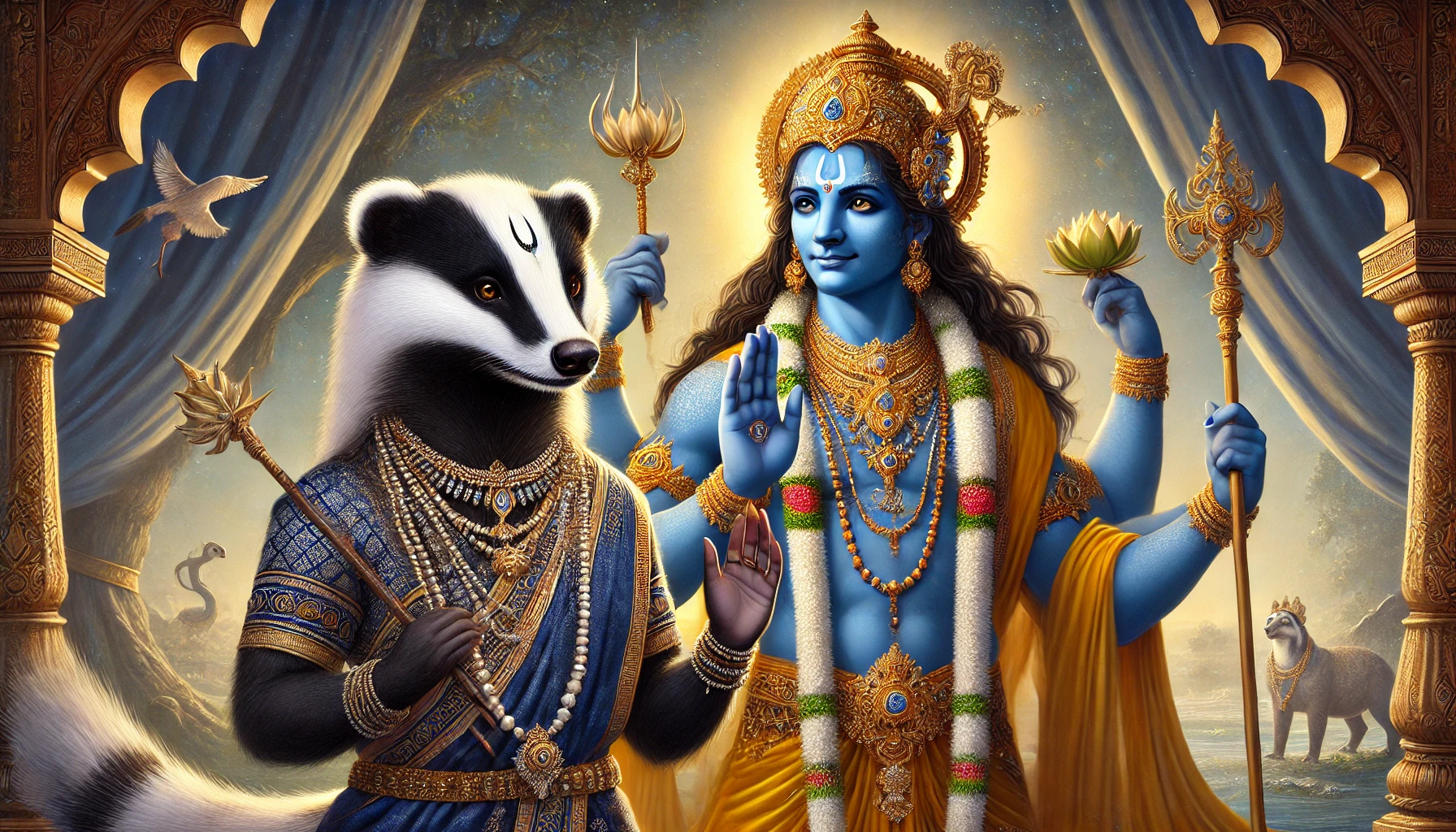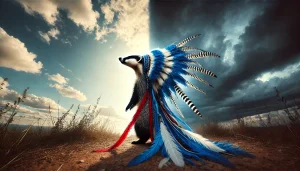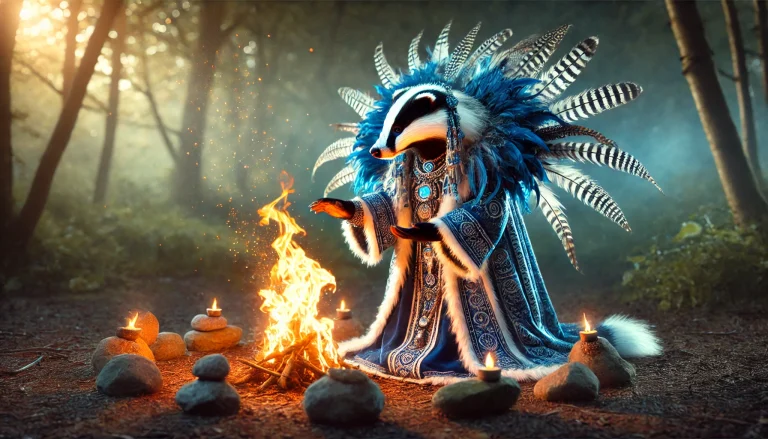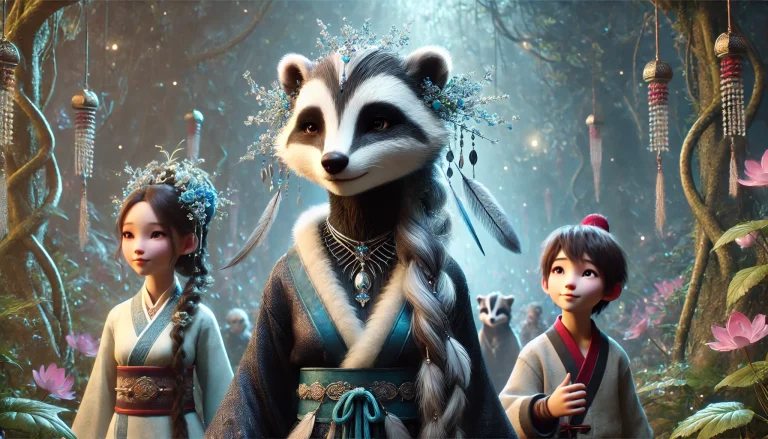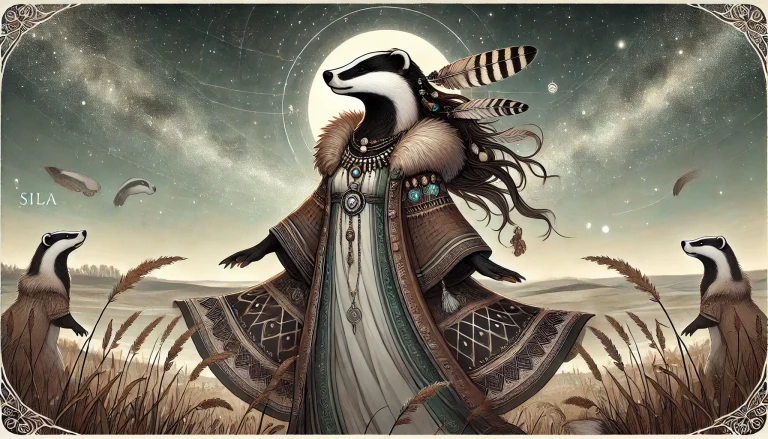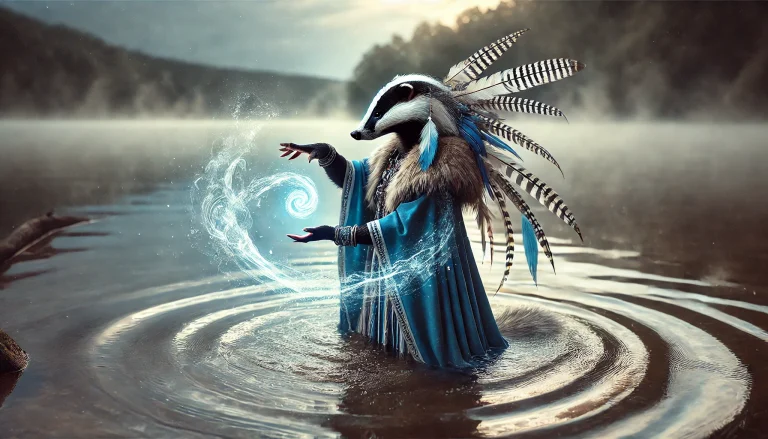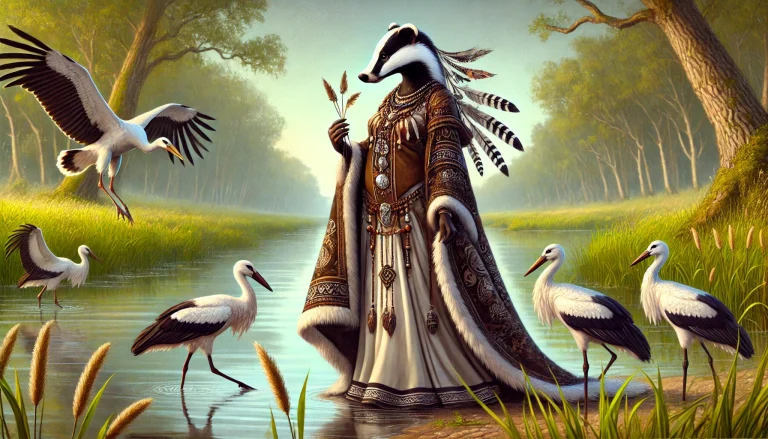In the vast pantheon of Hinduism, Vishnu occupies a position of supreme importance as one of the most revered and loved gods. Known as the Preserverhe is part of the Sacred TrimurtiThey are also known as Brahma (the Creator) and Shiva (the Destroyer), representing the balance and maintenance of all cosmic existence.
With his blue skin, which evokes the immensity of the infinite sky, and his four arms bearing sacred symbols, Vishnu personifies the divine consciousness that permeates the entire universe. His name derives from the Sanskrit root "vish"which means "to permeate" or "to be present everywhere", reflecting its omnipresent nature and its fundamental role in preserving the cosmic order, the dharma.
Over the millennia, the cult of Vishnu has evolved and expanded, giving rise to one of the greatest traditions within Hinduism: the Vaishnavism. His devotees, known as VaishnavasThey worship him as the Supreme Personality of God, the one who sustains and protects all creation.
One of Vishnu's most fascinating characteristics is his ability to manifest himself in different forms, known as avatarsHe comes to earth whenever the dharma is in danger. Through these divine incarnations, he descends to Earth to restore balance, protect his devotees and demonstrate his unconditional love for creation.
"I am the origin of everything; from Me everything emanates. The wise who know this truth perfectly worship Me with complete devotion."
(Bhagavad Gita 10.8)
Index
Symbolism and Representations
Vishnu's iconography is rich in symbolism and profound meanings. In his most common representations, he is portrayed as a divine being of extraordinary beauty, with dark blue skinevoking the infinitude of the cosmos. Its four arms carry sacred objects, each with a specific meaning:
- The Shell (Shankha): symbolizes the primordial sound OMthe purity and origin of existence.
- The Disk (Sudarshana Chakra): represents the divine mind and the power to destroy ignorance.
- The Apple (Gada): symbolizes the power of knowledge and divine strength.
- The Lotus Flower (Padma): represents spiritual purity and reality in constant evolution.
Vishnu is often depicted resting on the cosmic serpent Shesha (also known as Ananta), floating on the primordial waters. This image symbolizes the state of divine yoga between the cycles of creation. Its celestial vehicle is the mighty eagle Garuda, which represents the Vedas and spiritual wisdom.
"Vishnu is all that exists; he permeates the sky, the earth and all living beings. He is the past, the present and the future."
(Vishnu Purana, 1.22.38)
Lakshmi: The Divine Consort
Inseparable from Vishnu is his eternal consort, the goddess Lakshmi. As the goddess of prosperity, fortune and abundance, she perfectly complements Vishnu's preserving role. Together, they represent the perfect union between divine consciousness and the creative energy of the universe.
This divine partnership manifests itself in different ways through the avatars of Vishnu:
- Rama and Sita: represent ideal love and perfect dharma.
- Krishna and Radha: symbolize divine love in its deepest expression.
- Narayana and Lakshmi: personify cosmic preservation and universal abundance.
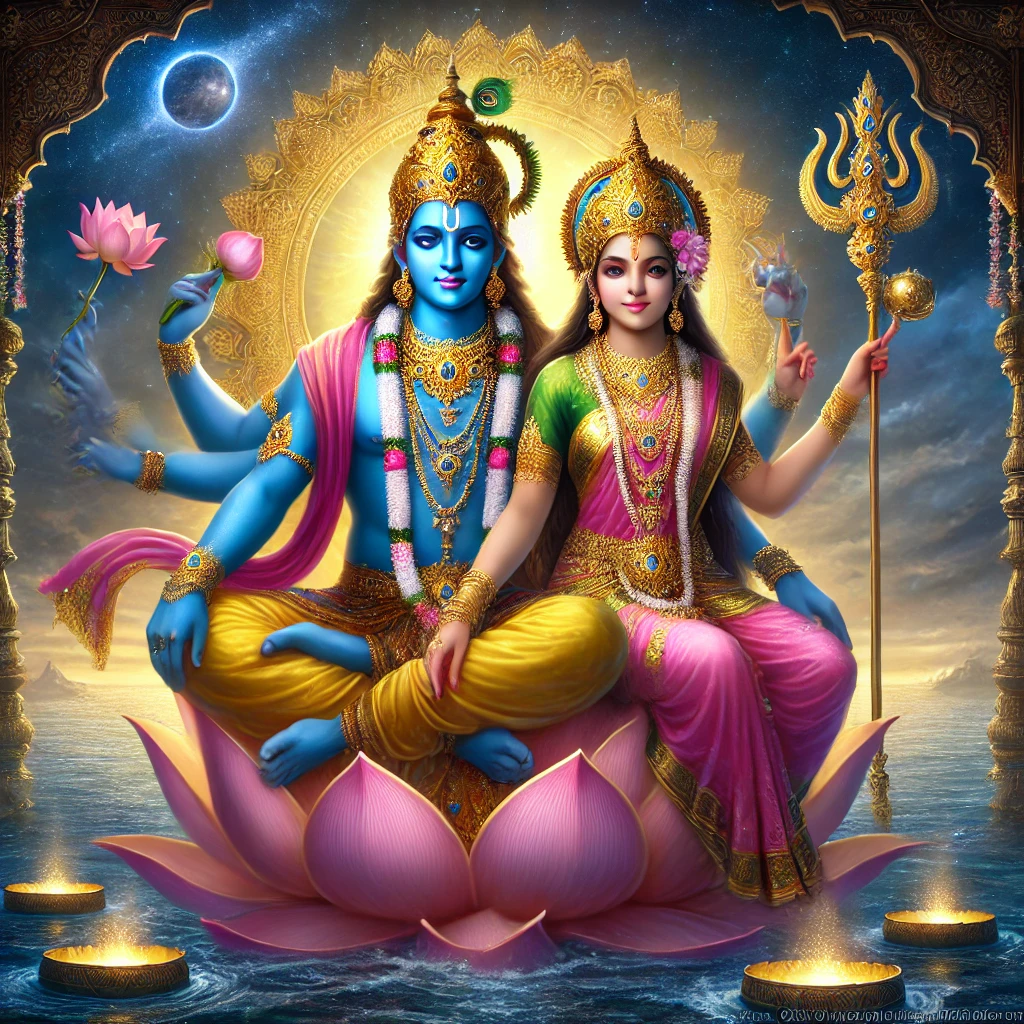
The Ten Avatars of Vishnu (Dashavatara)
"Whenever dharma declines and adharma (unrighteousness) prevails, I manifest. To protect the righteous, destroy evil and re-establish dharma, I come into existence in every age."
(Bhagavad Gita 4.7-8)
One of the most fascinating characteristics of Vishnu is his ability to manifest himself in different forms when the dharma (the cosmic order) is in danger. These divine incarnations, known as avatarsThese are traditionally counted as ten main manifestations, although there are accounts of more forms. Each avatar appears at a specific time to restore balance in the world.
- Matsya (The Fish):
The first avatar appeared in the form of a giant fish to save the sage Manu from the great flood and preserve Vedic knowledge. This manifestation represents the protection of spiritual wisdom. - Kurma (The Turtle):
Like a gigantic turtle, Vishnu held Mount Mandara on his back during the beating of the ocean of milk (Samudra Manthan), a mythical event that resulted in the production of the nectar of immortality. - Varaha (The Boar):
In this form, Vishnu rescued the Earth (personified as the goddess Bhudevi) from the depths of the cosmic ocean, where she had been taken by the demon Hiranyaksha. - Narasimha (The Lion Man):
Half man, half lion, this form emerged to defeat the demon Hiranyakashipu and protect his devotee Prahlada, demonstrating that true devotion is always protected. - Vamana (The Dwarf):
As a small Brahmin, Vamana asked the demon king Bali for three steps of land. On receiving the gift, he grew to cosmic proportions and covered the entire universe in three steps. - Parashurama (The Axe Warrior):
The first avatar in full human form, Parashurama appeared to restore balance when the warrior caste (Kshatriya) became corrupt and oppressive. As a Brahmin warrior, he fought against tyranny and the abuse of power. - Rama (The Ideal Prince):
Protagonist of the epic RamayanaRama personifies the dharma in its highest form. As king and ideal husband, he sets the standards for upright conduct and morality. His story with Sita is considered the ultimate example of love, duty and honor. - Krishna (The Divine Shepherd):
Perhaps the most beloved and well-known avatar, Krishna is considered the most complete manifestation of Vishnu. His exploits are described in Mahabharata and especially in Bhagavad Gitain which he reveals profound spiritual teachings. His relationship with Radha represents divine love in its purest form. - Buddha (The Enlightened One):
In some Hindu traditions, the historical Buddha is considered an avatar of Vishnu. This inclusion demonstrates Hinduism's ability to absorb and integrate different spiritual currents, although this is a controversial interpretation among scholars. - Kalki (What Is To Come):
The tenth avatar is yet to come. Prophesied to appear at the end of Kali Yuga (the current dark age), Kalki will appear on a white horse, wielding a flaming sword, to establish a new era of truth and righteousness.
Each of these avatars not only represents a mythological story, but also carries profound teachings about ethics, spirituality and the eternal struggle between good and evil. Through these manifestations, Vishnu demonstrates his ongoing commitment to the preservation of dharma and the protection of his devotees.
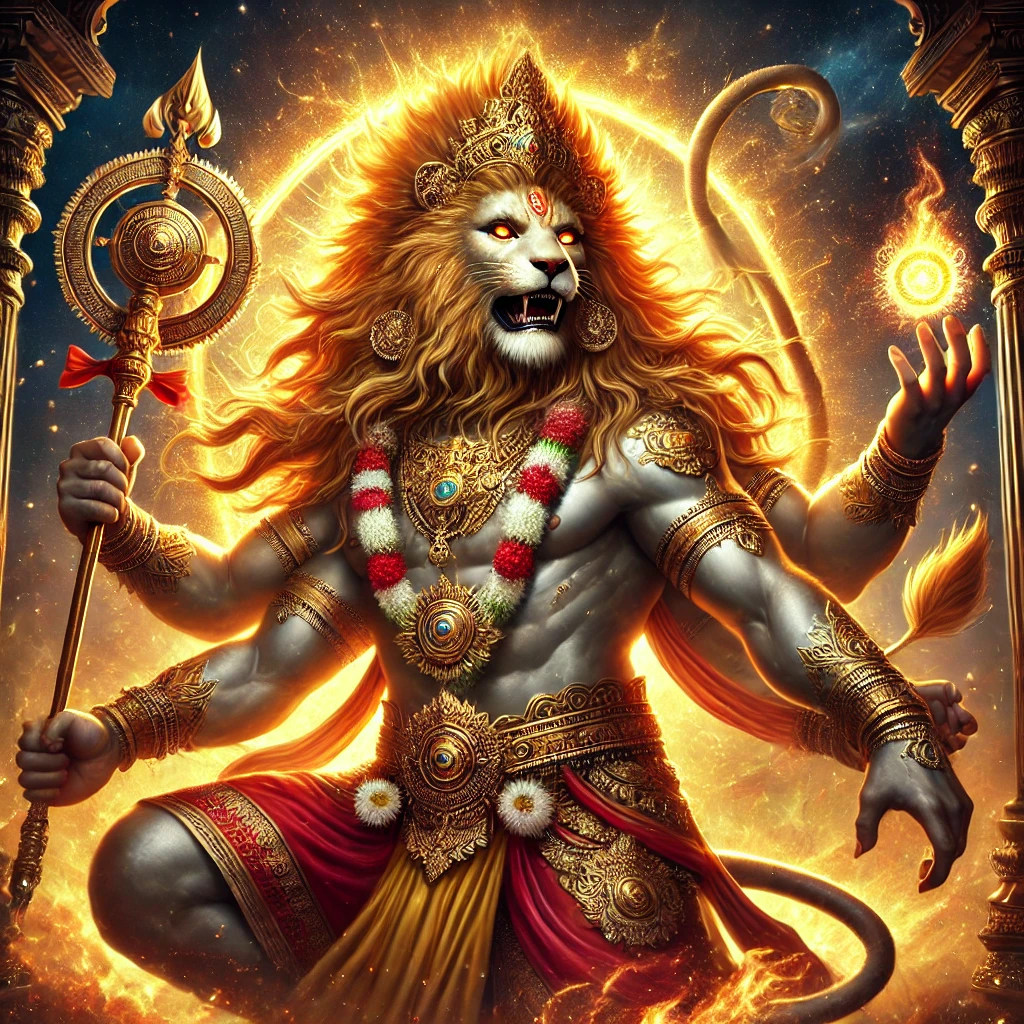
The Role of Vishnu in Hinduism
As a member of Sacred TrimurtiVishnu occupies a central position in Hinduism. His function as Preserver of the universe is fundamental to the continuity of cosmic existence. More than maintaining the universe, it represents the divine balance that permeates all of creation.
Divine Functions
- Preservation of the cosmic order (dharma, or moral and cosmic duty).
- Protection of the devout and the righteous.
- Maintaining the balance between the forces of good and evil.
- Sustaining the universe during the cycles of existence.
Sacred Texts
Vishnu is celebrated in various sacred texts of Hinduism:
- In the Upanishads: Its supreme nature is explored philosophically.
- In the Vedas: He is mentioned as a solar deity.
- In the Vishnu Purana: This text describes in detail his stories, glories and role as sustainer of the universe and defender of the dharma.
- In the Bhagavad Gita: Krishna, one of the most complete avatars of Vishnu, reveals profound spiritual teachings. This dialog between Krishna and Arjuna, present in the Mahabharataexplores themes such as duty, spirituality and the path to enlightenment.
Divine Functions
- Preservation of the cosmic order (dharma).
- Protection of the devout and the righteous.
- Maintaining the balance between the forces of good and evil.
- Sustaining the universe during the cycles of existence.
Sacred Texts
Vishnu is celebrated in various sacred texts of Hinduism:
- In the Vedas: He is mentioned as a solar deity.
- In the Vishnu Purana: Their stories and glories are described in detail.
- In the Bhagavad Gita: Through Krishna, he reveals profound spiritual teachings.
- In the Upanishads: Its supreme nature is explored philosophically.
Philosophical schools
O VaishnavismThe tradition dedicated to the worship of Vishnu gave rise to important philosophical schools:
- Vishishtadvaita from Ramanuja (qualified non-dualism): Vishnu is seen as the supreme reality, but distinct from souls and the material world.
- Dvaita of Madhva (dualism): Defends the absolute distinction between Vishnu, individual souls and the material universe.
- Achintya Bheda Abheda of Chaitanya (inconceivable difference and non-difference): Reconciles the simultaneous unity and difference between Vishnu and his creations.
These different philosophical interpretations explore the relationship between Vishnu, the individual soul and the material universe, offering different paths to understanding the supreme reality.
Worship and Devotion to Vishnu
Devotion to Vishnu, known as Vaishnavismis one of the largest and most influential traditions in Hinduism. The devotees of Vishnu, called VaishnavasThey have developed rich and profound spiritual practices over the millennia.
Devotional Practices
- Puja (worship ritual) daily with offerings of flowers, incense and food.
- Recitation of sacred mantras, especially the "Om Namo Narayanaya".
- Meditation on your divine forms.
- Study of sacred texts related to Vishnu.
- Pilgrimages to sacred temples.
- Celebration of festivals dedicated to him and his avatars.
Main Temples
Some of the most important Vaishnava pilgrimage centers include:
- Tirupati Temple (Andhra Pradesh): considered the most visited in the world.
- Padmanabhaswamy Temple (Kerala).
- Badrinath Temple (Himalayas).
- Temple of Jagannath (Puri).
- Ranganathaswamy Temple (Tamil Nadu).
Important festivals
Devotees celebrate various festivals throughout the year:
- Vaikuntha Ekadashi: especially auspicious day for worshipping Vishnu.
- Janmashtami: celebration of Krishna's birth.
- Ram Navami: celebration of the birth of Rama.
- Diwali: festival of lights, when Lakshmi is especially worshipped together with Vishnu.
- Tulsi Vivah: celebration of the mystical marriage between Vishnu and the Tulsi plant.
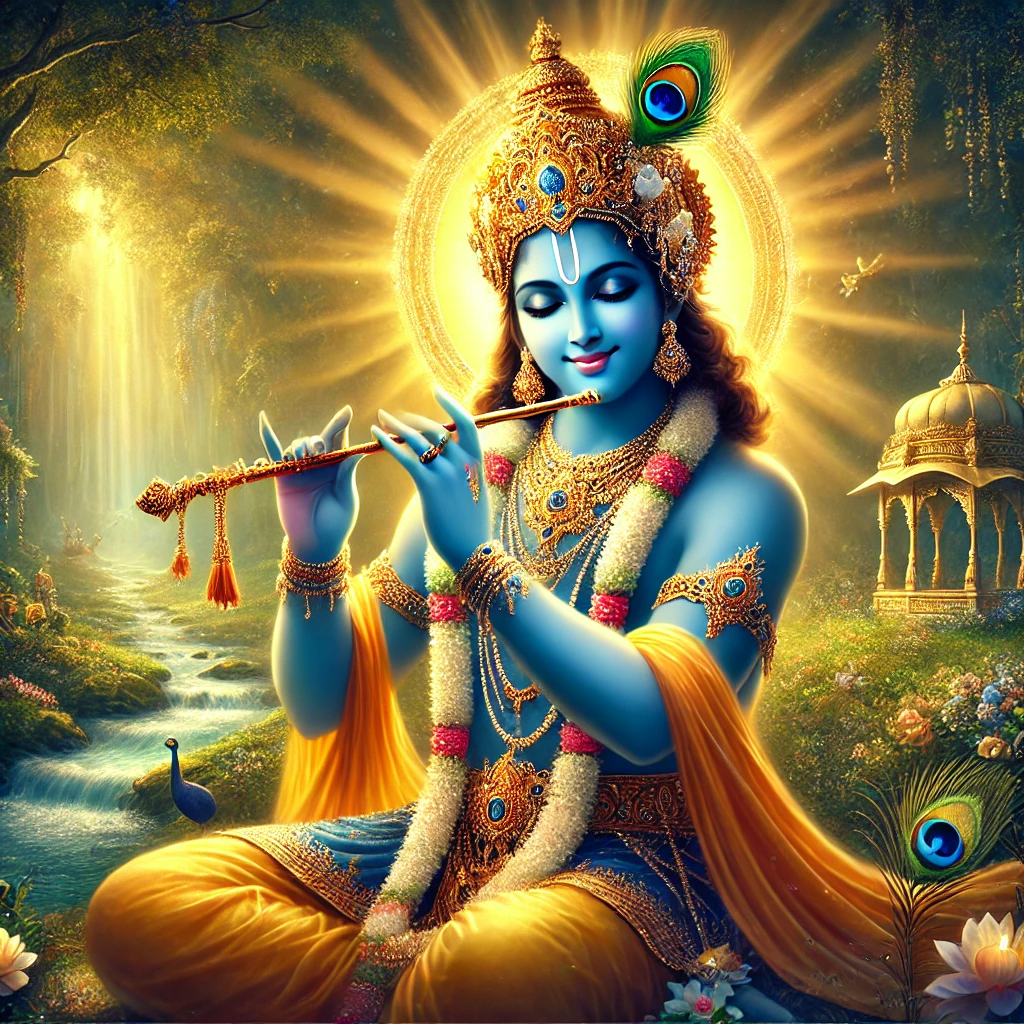
Vishnu's Cultural Influence
Vishnu's impact on Indian and world culture transcends the purely religious aspect, permeating various spheres of social, artistic and philosophical life.
In Art
- Vishnu's iconography has inspired some of the most beautiful works of Indian art.
- Its representations can be found in ancient and modern temples.
- Classical Indian art developed specific patterns to portray Vishnu and his avatars.
- Paintings, sculptures and murals telling their stories adorn temples and museums all over the world.
- Contemporary art continues to reinterpret its symbols and narratives.
In Literature
- The epics Ramayana e Mahabharata, which feature their avatars Rama and Krishna, are pillars of world literature.
- Mystical poets like Tulsidas e Deaf composed immortal works dedicated to him.
- Vaishnava devotional literature continues to inspire new generations of writers.
- His stories are constantly being adapted for different formats and audiences.
In Contemporary Society
- His teachings continue to guide ethical and moral principles.
- Values associated with Vishnu, such as protection, preservation and balance, influence sustainable practices.
- Its symbols are often used in company names and brands.
- The concept of avatarThe digital culture has adopted the idea of a "digital world", which originated from its incarnations.
- His stories are adapted for modern media: films, series, comics and games.
Global Impact
- Yoga and meditationpractices associated with the Vaishnava tradition have gained worldwide popularity.
- Philosophical concepts of Vaishnavism influence contemporary spiritual movements.
- The message from Bhagavad Gita continues to resonate with people from different cultures.
- Festivals such as Diwali are celebrated internationally.
- His teachings on harmony and preservation inspire discussions about ecology and sustainability.
This lasting influence demonstrates how Vishnu, far beyond being a Hindu deity, became a universal symbol of preservation, balance and spiritual wisdom. He continues to inspire and guide people all over the world in their search for a more meaningful and harmonious life.
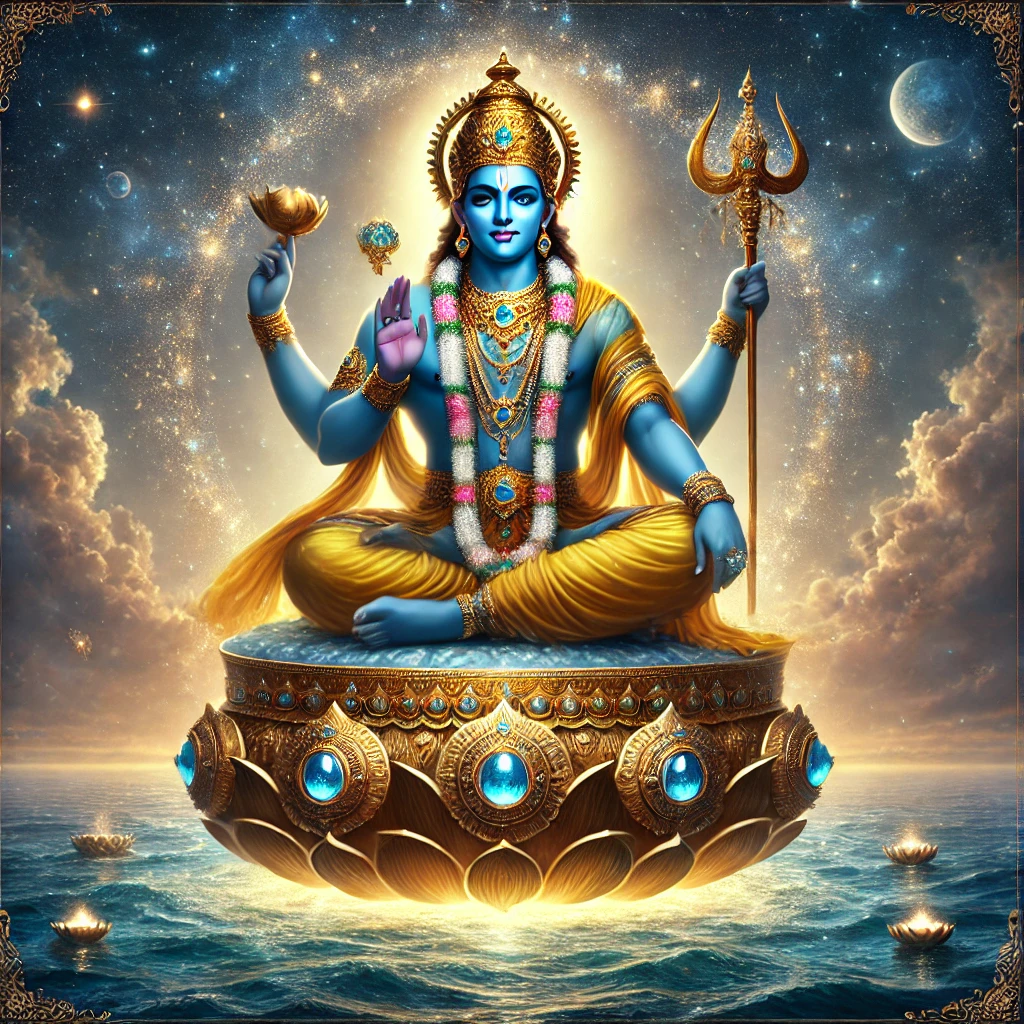
Curiosities about Vishnu
The Divine Color Blue
Vishnu's blue color has a fascinating history. According to Hindu scriptures, his skin turned blue when he drank poison from the ocean of milk to save the universe. Another interpretation suggests that blue represents cosmic infinitysymbolizing its unlimited and omnipresent nature. The color blue is also associated with the sky and the ocean, elements that represent the vastness of his existence.
The Yogic Sleep
Vishnu is often depicted sleeping on a snake Shesha in the cosmic ocean. This is no ordinary sleep, but a state of deep meditation called Yoga Nidra. During this mystical sleep, he holds all the universes in his divine consciousness.
The Names of Vishnu
Vishnu possesses 1,000 different namesEach one describes an aspect of his divine nature. This list of names is recited in the Vishnu SahasranamaThis text is highly respected by devotees. Some of the best known are:
- Narayana: He who dwells in the waters.
- Hari: The one who removes obstacles.
- Govinda: Protector of cows and the Earth.
The Mysterious Temple
O Padmanabhaswamy Temple in Kerala, dedicated to Vishnu, is known for having one of the largest collections of treasures in the world in its secret chambers. One of these chambers remains closed, protected by mystical doors that, according to legend, can only be opened by specific mantras.
The Sacred Plant
A Tulsi (holy basil) is considered a manifestation of Vishnu's love. Devotees grow this plant in their homes and use its leaves in rituals. It is said that Vishnu especially appreciates offerings that include Tulsi leaves.
The Divine Bird
GarudaGaruda, the mount of Vishnu, is a half-man, half-eagle divine being known for his extraordinary strength and loyalty. There is a fascinating story about how Garuda became immortal and freed his mother from slavery through a mission to steal the nectar of immortality from the gods.
The Magic Shell
Vishnu's shell, called Panchajanya, has a unique origin. It is said that it was obtained after the defeat of a powerful sea demon called Panchajana, who lived at the bottom of the ocean inside a conch shell. After defeating the demon, Vishnu adopted the conch shell as one of his symbols.
The Sudarshana Disc
O Vishnu's spinning diskThe Sudarshana Chakra is not just a weapon, but represents the purified mind and the power of time. It is said to rotate constantly, symbolizing the eternal cycle of time and Vishnu's constant vigilance over the universe.
The Four Ages
Vishnu is the guardian of four ages (yugas) of the cosmic cycle:
- Satya Yuga: the age of truth.
- Bullshit Yuga: when the dharma begins to diminish.
- Dwapara Yuga: marked by further decline.
- Kali Yuga: the current era of conflict.
The Sacred Number
The number 8 is especially associated with Vishnu:
- He has eight main qualities.
- He is the guardian of the eight directions.
- He has eight wives besides Lakshmi.
- Your album has eight sides.
The Vishvarupa
One of the most spectacular forms of Vishnu is the VishvarupaHe reveals his cosmic nature by showing all the universes existing within his divine body. This form was shown by Krishna in the Bhagavad Gita.
"He who upholds the heavens and sustains the earth; He who rests in the cosmic ocean and contains all the worlds within himself, is Lord Vishnu."
(Vishnu Purana, 1.9.67)
Conclusion: Vishnu's Eternal Relevance
Vishnu, in his divine magnitude, represents much more than a deity of the Hindu pantheon - he embodies universal principles that remain relevant in our contemporary age. Through its multiple manifestations, sacred symbols and profound teachings, it offers us a model of how to maintain balance in an ever-changing world.
Your partnership with Lakshmi teaches us about the necessary harmony between preservation and prosperity. Their avatars (divine incarnations) show how divinity manifests itself in different ways to protect people. dharma and guide humanity. Whether through the ideal love of Rama and Sitafrom the profound wisdom of Krishna in Bhagavad Gitaor the promise of renewal represented by KalkiEach aspect of Vishnu holds valuable lessons for our spiritual journey.
The cult of Vishnu, far from being just an ancient tradition, remains vibrant and dynamicIt has adapted to the needs of modern times while maintaining its sacred essence. Its temples remain active centers of devotion, its festivals are celebrated with fervor, and its teachings continue to inspire millions of people around the world.
In an era marked by environmental, social and spiritual imbalances, Vishnu's message about preservation, protection and balance becomes even more significant. Texts such as Vishnu Purana and Bhagavad Gita continue to offer timeless insights, connecting the mythology with philosophical and practical issues of the contemporary world.
Thus, Vishnu remains a beacon of spiritual wisdomWe are constantly reminded of our responsibility to preserve not only the material world, but also the eternal values that sustain human existence.
I'm passionate about magic and spirituality, always looking for new knowledge about rituals, energies and the mystical universe. Here, I share magical practices and spiritual tips for those who want to connect more deeply with themselves and the world around them, all in a light and accessible way.

